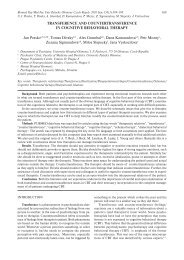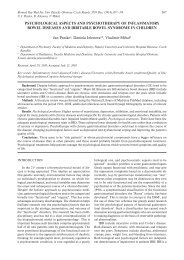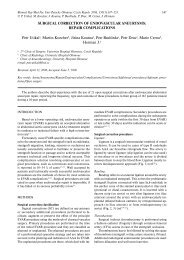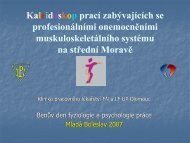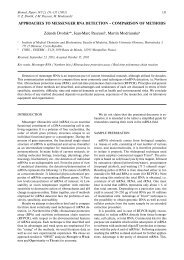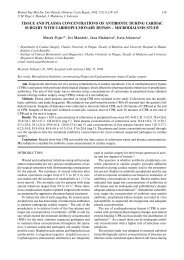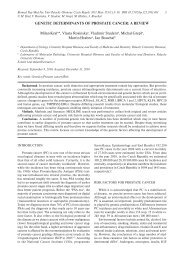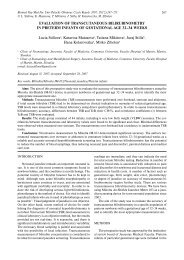A MICROBIOLOGICAL APPROACH TO ACNE VULGARIS Yvona ...
A MICROBIOLOGICAL APPROACH TO ACNE VULGARIS Yvona ...
A MICROBIOLOGICAL APPROACH TO ACNE VULGARIS Yvona ...
You also want an ePaper? Increase the reach of your titles
YUMPU automatically turns print PDFs into web optimized ePapers that Google loves.
A microbiological approach to acne vulgaris31Their effect is based on the non-specific modulation ofthe immune system of patients 9, 12, 20–24, 33, 34 . The vaccinotherapyis usually applied together with external treatmentand follows the systemic antibiotic therapy whenthe pronounced inflammatory manifestations are eliminated43, 44 . Contrarily to wide-specter antibiotics thatcan cause the recession of the disease without any effecton possible recurrent attacks after the end of their application,the use of oral vaccines reveals a long-termfavorable effect 23, 24 .The Teaching Hospital in Olomouc has a long historyof vaccinotherapy use. Whole cell stockvaccines ofstandard composition are preferred (Propionibacteriumacnes, Staphylococcus aureus, Staphylococcus epidermidisin the ratio 1:1:1). They are prepared using the cellophanetechnique with following inactivation of obtainedgerms and their lyophilization. They can be applied assubcutaneous injection or in oral forms of drops, capsulesor tablets. Basing on the experience, it can bestated that the vaccinotherapy shows a very good effectwithout unwanted side effects in most patients. Thetherapy failed at less than 2 % of patients, no worseningof the state was registered. The differences in the effectivenessof individual drug forms (injections, tablets,capsules and drops) was not described 23, 37–39 . It wasconfirmed that the proper onset of vaccination in mildforms of acne prevents the development of severe caseswith permanent consequences. Vaccines can be appliedin all cases of acne papulopustulosa, conglobata, indurationor abscess forms. Priors to the vaccine therapy,biochemical, hematological and immunological examinationsare to be performed. When a clinical improvementis reached as the result of antibiotic therapy, it isrecommendable to continue with vaccinotherapy, eventuallywith another immunotherapy, according to theresults of immunological tests 15, 45, 46, 49 .CONCLUSIONIt can be concluded that acne is a typical disease ofyoung age and it often represents a major psychic traumafor the patients. The results of non-treated or insufficientlytreated disease are frequent scars, also influencingnegatively the psychic condition of patients. Regardingto the constantly improving diagnostic methodsand various therapeutic possibilities, it is feasible toreach a favorable therapeutic effect in most cases. Thedisease can thus be influenced at its beginning, estheticdamage can be prevented and the economic costs resultingfrom chronic character of the process can bedecreased.ACKNOWLEDGEMENTSThe study was supported by the Research Project MSM151100002.REFERENCES1. Auffret N (2000) Acne today. What’s new? Presse Medicale.29(19):1091–7.2. Bednář M, Fraňková V, Schindler J, Vávra J (1996) Lékařskámikrobiologie. Marvil, 292–293.3. Bershad SV (2001) The modern age of acne therapy: a review ofcurrent treatment options. Mount Sinai Journal of Medicine.68 (4–5):279–86.4. Burkhart CG, Cantrill J, Butcher CL, Lehmann PF (1999) Propionibacteriumacnes: interaction with complement and developmentof an enzyme-linked immunoassay for detection of antibody.Int J of Derm 38 (3): 200–3.5. Burkhart CG, Burkhart CN, Lehmann PF (1999) Acne: a reviewof immunologic and microbiologic factors. Postgraduate MedicalJ. 75 (884): 328–31.6. Březina Z (1986) Několik poznámek k imunomodulátorům STAVAa STAFAL. Prakt Lék (Praha) 66: 430–431.7. Coates P, Vyakrnam S, Eady EA, et al. (2002) Prevalence ofantibiotic-resistant propionibacteria on the skin of acne patients:10-year surveillance data and snapshot distribution study. Br JDermatol 146 (5): 840–8.8. Carrasco DA, Vander Straten M, Tyring SK (2002) A review ofantibiotics in dermatology. J Cutan Med Surg 6 (2): 128–50.9. Černá I, Baová D, Horák V, et al. (1977) Preparation of stafyloccocalvaccine and its application to chronic infections. ActaUniv Palacki Olomuc, Fac Med 83: 349–361.10. Federman DG, Kirsner RS (2000) Acne vulgaris: pathogenesisand therapeutic approach. American Journal of Managed Care 6(1): 78–87.11. Fitzpatrick TB, et al. (1997) Color atlas and synopsis of clinicaldermatology. McGraw-Hill comp. 2–14.12. Fleming A (1909) On the etiology of acne vulgaris and its treatmentby vaccine. Lancet 176: 1035–1038.13. Goulden V, McGeown Ch, Cunliffe WJ (1999) The familiar riskof adult acne: a comparison between first-degree relatives ofaffected and unaffected individuals. Br J Dermatol 141 (2):297–300.14. Chan JJ, Rohr JB (2000) Acne vulgaris: yesterday, today andtomorrrow. Australasian Journal of Dermatology 41: 69–72.15. Chu T, Munn S, Basarab T (1996) Current issues in dermatology.Acne. London: Maxim Medical, 1–57.16. Jappe U (2000) Superantigens and their association with dermatologicalinflammatory diseases: facts and hypotheses. Acta Dermato-Venerologica,80 (5): 321–8.17. Jappe U, Inhgam E, Henwood J, Holland KT (2002) Propionibacteriumacnes and inflammation in acne; P. Acnes has T-cell mitogenicactivity. Br J Dermatol, 146 (2): 202–9.18. Kasprowicz A, Klosinski A, Heczko PB (1986) Leczenie zmiantradzikowych przy zastowaniu antigénov Propionibacterium wformie szcepionki doustnej. Med Došw Microbiol; 38: 73–78.19. Korandová H, Viktorinová M (1994) Zevní léčba akné kyselinouazelainovou. Čs Derm; 69: 189–193.20. Koukalová D, Koousek R, Hájek V, Kolář M (1992) Experimentalnonspecific immunostimulation by the Propionibacterium acnesvaccine. Acta Univ Palacki Olomuc, Fac Med; 133: 19–23.21. Koukalová D, Viktorinová M (1992) Kožní testy s mikrobiálnímiantigeny. Chronické stafylokokové pyodermie. Čs Derm; 67:133–139.22. Koukalová D, Viktorinová M (1992) Kožní testy s mikrobiálnímiantigeny. Mikrobiální ekzém. Čs Derm; 67: 269–274.23. Koukalová D, Viktorinová M (1995) Perorální vakcinoterapiev dermatologii. Epidemiol Mikrobiol Imunol; 44: 1: 36–43.24. Kučerová R, Buček M, Viktorinová M, Sheetyová R (1998) Acnevulgaris jako terapeutický problém – současné možnosti léčbyv zrcadle našich zkušeností. Olomoucké dermatologické přednáškovéodpoledne, Olomouc 1998.25. Kurokawa I, Nishijima S, Kawabata S (1999) Antimicrobial susceptibilityof Propionibacterium acnes isolated from acne vulgaris.European Journal of Dermatology; 9 (1): 25–8.




